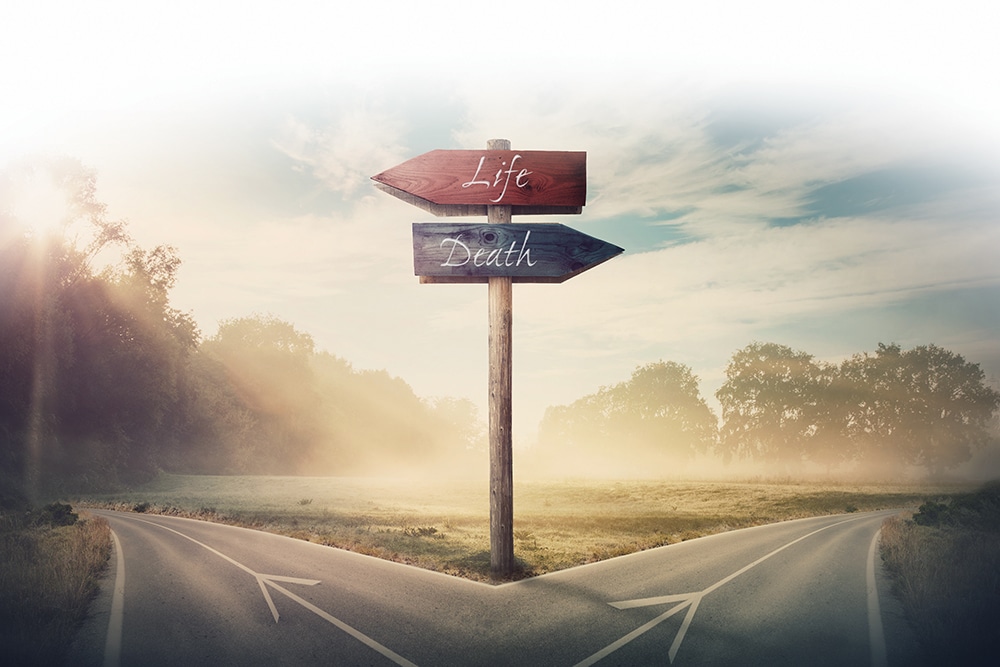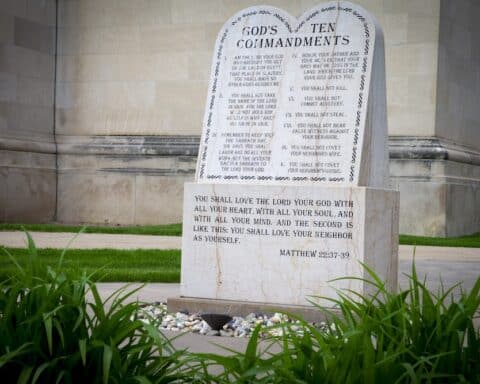This is the sixth installment of a 10-part series looking at the Ten Commandments.
“Thou shall not.” We hear those words six times with the final six commandments. And it begins with this Fifth Commandment in a really heavy way: Thou shall not … kill.
We already heard one “thou shall not” in the Second Commandment, concerning not taking the Lord’s name in vain. It is not too hard to see the positive reverse of the Second Commandment, which is to respect, revere and honor the name of the Lord. With the final six commandments, imagining the positive reverse is not as easy.
If you are like me, you were not planning to commit murder. So maybe the Fifth Commandment is just a freebie so we can say, “Well at least I didn’t kill anybody.”
Is there a positive reverse to this commandment to not kill? Yes, and it makes the Fifth Commandment a lot more challenging. It also draws up deeper into the life of Christ.
Moses’s farewell
Moses, who led the Israelites out of slavery and across the desert towards the Promised Land, not only delivered the Ten Commandments to the people but also taught them how to observe the commandments so as to become whom God called them to be. As part of his last act of leadership as God’s anointed prophet, Moses clearly named the paths that lie before people across the River Jordan as they prepare to enter their promised land. (See especially Dt 30:15-19)
One thing is clear in Moses’s farewell: there is no third way. There are only two ways: the way of life and the way death, the way of prosperity and the way of destruction, the way of truth and the way of falsehood. In summary, he says, “I have set before you life and death, the blessing and the curse. Choose life, then, that you and your descendants may live” (Dt 30:19).
Because there are only two ways, a choice is unavoidable. You choose one or the other. There is no default or neutral position. You cannot simply avoid one and not choose the other way: in order to avoid one way you must choose the other way.
Therefore, avoiding the way of death, destruction and falsehood, means you must choose life.
That is the flip side of the Fifth Commandment. It is not possible to simply avoid “killing” without actively supporting and choosing life.
Choosing life
There is no neutral position because we are responsible for each other. We are created that way: that is what’s true about us. What is truly good for each of us always has to do with the good we share in common.
This is why the “do no harm” kind of morality is a fallacy. Taking up the position of “well I never hurt anyone” — or even, “at least I never killed anybody” — is meaningless before the Lord. We cannot be responsible for each other if we just leave each other alone. To put a fine point on it: to fail in the action of serving each other’s good is in fact to harm one another. There is no third way.
St. Catherine of Siena illuminated this truth. In her “Dialogue,” which is a record of her conversations with the Lord in the depths of her mystical prayer, she recounts what the Lord said to her:
“Here [on this earth] you owe each other help in word and teaching and good example, indeed in every need of which you are aware, giving counsel as sincerely as you would to yourself, without selfishness. If you do not do this because you have no love for your neighbors, you do them special harm, and this as persistently as you refuse them the good you could do. … I have told you how every sin is done by means of your neighbors, because it deprives them of your loving charity, and it is charity that gives life to all virtue. So that selfish love which deprives your neighbors of your charity and affection is the principle and foundation of all evil.”
Charity is the rule of life, which means that if we do not act for the good of our neighbor, we are depriving them of what we owe them. That the “neutral position” of just “do no harm” is actually doing harm. Indifference is the illusion of some kind of third way — but there is no third way, so that if we do not choose life, we then choose death. That is a perpetual challenge and an invitation to freedom because the true promised land is in sharing life with each other. That is the fruit of Christ’s sacrifice.
What this all means is that the Fifth Commandment — thou shall not kill — is actually a radical call to a regular examination of conscience. We must inquire constantly as to how we are promoting the life of others or failing to do so. Thou shall not kill is about a firm, resolute, daily and lifelong active commitment to supporting and enriching life: our own, others and the life we share in common.
Obviously, directly or even indirectly killing or harming another person is complicit in the way of death. But to take this commandment in all seriousness means joining in the life of Christ who did not just avoid doing us harm, but does everything for our good.
Cultures of life
In closing, we can think about promoting the life of the two particularly vulnerable groups: the elderly and the unborn.
By not holding close to the elderly and forming bonds with them, we fail to choose life. This is not just about euthanasia, though it is about that. Choosing life means that for those of us who find ourselves more at the center of the life of society — plugged in and connected to others — we are responsible for including those who might be cut off due to age or frailty or needs or inability to work. Our commitment to them is the bond of charity.
Likewise, by not creating communities and governments that support the conditions conducive to bearing and raising children, we fail to choose life. This is not just about abortion, though it is certainly about that. Women who have carried children know how burdensome that can be, even while it is totally beautiful. The burden is not just for nine months but often for closer to two years. I have been close to that burden with my wife, who has six times carried children in her womb, given birth and nourished our babies from her body. She has undergone all kinds of physical, emotional, psychological and spiritual change through those times — in different ways for each child. She would do it all again, but that doesn’t mean it wasn’t hard. It was hard, even with a very stable home, excellent health care and lots of support. That’s what it takes, not just for her but for everyone.
Choosing life here means not just avoiding abortion and advocating against it — though it does mean that. It also means acting and praying with positive contributions to create the conditions for life.
Practices for life
To observe the Fifth Commandment requires a regular habit of examining our consciences — individually and together as families. We can ask questions like:
- Whose suffering have I seen and have I responded to their suffering?
- How am I suffering and have I allowed others to know and share in my suffering?
- What needs are there in my immediate community for promoting a culture of life, especially for those with the least support and the least access to help?
- How might I be blinded by my comfort and not able to see the suffering of others? Where could I go, what could I do, to change that?
The point here is to flip the Fifth Commandment around and stop taking it as the one that all of us who aren’t murderers just take for granted. The Fifth Commandment in full is an invitation to acquire those firm attitudes and stable dispositions that are really necessary to choose life.
Leonard J. DeLorenzo, Ph.D., works in the McGrath Institute for Church Life and teaches theology at the University of Notre Dame. His new book is “A God Who Questions” (OSV, $12.95).





